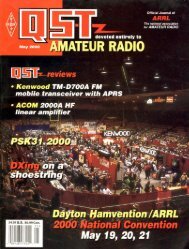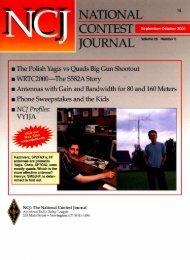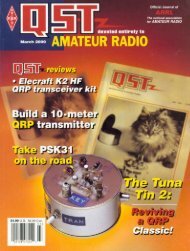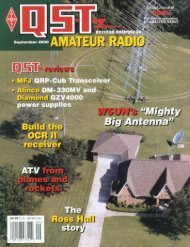You also want an ePaper? Increase the reach of your titles
YUMPU automatically turns print PDFs into web optimized ePapers that Google loves.
THE AMERICAN RADIO<br />
RELAY LEAGUE INC<br />
The American Radio Relay League Inc is a<br />
noncommercial association of radio amateurs,<br />
organized for the promotion of interest in<br />
Amateur Radio communication and experimentation,<br />
for the establishment of networks to provide<br />
communication in the event of disasters or other<br />
emergencies, for the advancement of the radio art<br />
and of the public welfare, for the representation of<br />
the radio amateur in legislative matters, and for the<br />
maintenance of fraternalism and a high standard of<br />
conduct.<br />
ARRL is an incorporated association without<br />
capital stock chartered under the laws of the State<br />
of Connecticut, and is an exempt organization<br />
under Section 501(c)(3) of the Internal Revenue<br />
Code of 1986. Its affairs are governed by a Board<br />
of Directors, whose voting members are elected<br />
every three years by the general membership. The<br />
officers are elected or appointed by the directors.<br />
The League is noncommercial, and no one who<br />
could gain financially from the shaping of its affairs<br />
is eligible for membership on its Board.<br />
“Of, by, and for the radio amateur,” the ARRL<br />
numbers within its ranks the vast majority of active<br />
amateurs in the nation and has a proud history of<br />
achievement as the standard-bearer in amateur affairs.<br />
A bona fide interest in Amateur Radio is the only<br />
essential qualification of membership; an Amateur<br />
Radio license is not a prerequisite, although full<br />
voting membership is granted only to licensed<br />
amateurs in the US.<br />
Membership inquiries and general correspondence<br />
should be addressed to the administrative<br />
headquarters; see page 10 for detailed contact<br />
information.<br />
Founding President (1914-1936)<br />
Hiram Percy Maxim, W1AW<br />
Officers<br />
President: JIM D. HAYNIE,* W5JBP,<br />
3226 Newcastle Dr, Dallas, TX 75220-1640;<br />
(214-366-9400); w5jbp@arrl.org<br />
First Vice President: JOEL M. HARRISON,*<br />
W5ZN, 528 Miller Rd, Judsonia, AR 72081;<br />
(501-729-4152); w5zn@arrl.org<br />
Vice President: KAY C. CRAIGIE, WT3P,<br />
5 Faggs Manor Ln, Paoli, PA 19301; (610-993-9623);<br />
wt3p@arrl.org<br />
Vice President: JOHN C. KANODE, N4MM,<br />
1741 Old Chapel Rd, Boyce, VA 22620;<br />
(540-837-1340); n4mm@arrl.org<br />
International Affairs Vice President:<br />
RODNEY STAFFORD, W6ROD, 5155 Shadow<br />
Estates, San Jose, CA 95135; (408-274-0492);<br />
w6rod@arrl.org<br />
Executive Vice President: DAVID SUMNER,* K1ZZ<br />
Secretary: DAVID SUMNER, K1ZZ<br />
Treasurer: JAMES McCOBB Jr, W1LLU<br />
Chief Financial Officer: BARRY J. SHELLEY, N1VXY<br />
Staff<br />
Technical Relations Manager<br />
Paul Rinaldo, W4RI<br />
Legislative and Public Affairs Manager<br />
Steve Mansfield, N1MZA<br />
General Counsel<br />
Christopher Imlay, W3KD<br />
PUBLICATIONS<br />
Manager: Mark Wilson, K1RO<br />
Advertising Department<br />
John Bee, N1GNV, Manager<br />
Circulation Department<br />
Debra Jahnke, Manager<br />
Katherine Capodicasa, N1GZO, Deputy Manager<br />
MEMBERSHIP SERVICES<br />
Manager: Wayne Mills, N7NG<br />
FIELD & EDUCATIONAL SERVICES<br />
Manager: Rosalie White, K1STO<br />
VOLUNTEER EXAMINER DEPARTMENT<br />
Manager: Bart Jahnke, W9JJ<br />
Business Staff<br />
Business Manager: Barry J. Shelley, N1VXY<br />
Comptroller: LouAnn Campanello<br />
Information Services: Don Durand, Manager<br />
Office Manager: Robert Boucher<br />
*Executive Committee Member<br />
“IT SEEMS TO US…”<br />
Forty Meters: A Gordian Knot<br />
On this page in August we explained how<br />
the 40-meter band got the way it is, with amateurs<br />
having to compete with powerful broadcasting<br />
stations outside the Americas in the<br />
upper two-thirds of the band. We reported that<br />
WRC-<strong>2000</strong> in Istanbul had recommended that<br />
the realignment of the amateur and broadcasting<br />
services allocations around 7 MHz be<br />
placed on the agenda of the next such conference,<br />
in 2003.<br />
As expected, the ITU Council accepted this<br />
recommendation. Also on the WRC-2003<br />
agenda are two related items: Changes necessary<br />
to implement digital modulation techniques<br />
in HF broadcasting, and examination of<br />
the adequacy of HF broadcasting allocations<br />
between 4 and 10 MHz. Inclusion of the latter<br />
item is something of a surprise. It was on a short<br />
list of items that WRC-<strong>2000</strong> had recommended<br />
if additional budgetary and conference resources<br />
could be provided, but few thought that<br />
Council would be able to do so in the prevailing<br />
“no budget increase” environment.<br />
The long-standing IARU objective is an exclusive,<br />
worldwide amateur allocation of no<br />
less than 300 kHz in the vicinity of 7 MHz, as<br />
was the case prior to 1938. While the WRC-<br />
2003 agenda offers the possibility of achieving<br />
this objective, let’s not kid ourselves: It will<br />
not be easy. Inclusion of the other HF broadcasting<br />
items makes it more difficult to resolve<br />
the 7-MHz issue. Here’s why.<br />
This will be the third attempt to fix 40 meters.<br />
The first, in 1979, was a part of a bottom-to-top<br />
review of the international radio regulations<br />
and the table of frequency allocations. Several<br />
administrations proposed separate 7-MHz amateur<br />
and broadcasting allocations at WARC-79,<br />
but most of these proposals required reductions<br />
in the adjacent allocations to the fixed service.<br />
At the time, the international broadcasters encountered<br />
strenuous opposition to expansion<br />
from developing countries, many of whom relied<br />
on HF fixed links for basic telecommunications<br />
services. The failure to find a 40-meter<br />
solution satisfactory to amateurs and broadcasters<br />
was not unique; international broadcasters’<br />
gains at WARC-79 were limited to the bands<br />
above 9500 kHz, which are less useful for domestic<br />
fixed services. Below that frequency,<br />
they were shut out.<br />
Broadcasters were only slightly more successful<br />
in 1992. At that conference, they obtained<br />
future access to an additional 200 kHz<br />
below 10 MHz: 5900-5950, 7300-7350, and<br />
9400-9500 kHz. However, the new bands came<br />
with strings attached. They (along with an additional<br />
590 kHz above 10 MHz) were only to<br />
be used for single-sideband (SSB) emissions.<br />
HF broadcasters were also required to complete<br />
the transition from double-sideband to SSB<br />
with all double-sideband transmissions to cease<br />
by the end of 2015.<br />
The SSB envisioned for broadcasting was<br />
not the same SSB that has been the dominant<br />
amateur HF voice mode for the past 35 years.<br />
Instead of completely suppressing the carrier,<br />
broadcasters were to transmit a pilot carrier at<br />
a level about 12 dB below peak envelope power.<br />
The plan was for receiver manufacturers to<br />
design and market SSB receivers with synchronous<br />
detectors.<br />
That was the plan, but somehow it never quite<br />
came together. Most broadcasters’ hearts were<br />
never in it. They didn’t like the idea of having<br />
to buy new transmitters (HF transmitters have<br />
an extremely long service life) and they didn’t<br />
like listeners having to buy new receivers in<br />
exchange for what they generally regarded as<br />
marginal improvements in reception quality. A<br />
WRC-<strong>2000</strong> report said: “No SSB receiver<br />
equipped with a synchronous demodulator has<br />
been identified in the price range up to $200.<br />
Even in the price range from $200 to $600, only<br />
15% of the HF receiver models identified are<br />
equipped with a synchronous detector.” While<br />
exact figures are not available, it is clear that<br />
only a tiny percentage of the estimated 500<br />
million to 700 million HF receivers in the world<br />
are equipped for SSB.<br />
In recent years, some HF broadcasters have<br />
become enthusiastic about digital modulation.<br />
An international consortium, Digital Radio<br />
Mondiale (DRM), has made considerable<br />
progress toward developing a proposed worldwide<br />
standard for digital sound broadcasting<br />
below 30 MHz. An ITU Task Group meeting in<br />
Geneva in mid-October (around the time this<br />
issue of <strong>QST</strong> is mailed) is expected to approve<br />
such a standard. This will set the stage for its<br />
early adoption as an ITU-R Recommendation<br />
as well as for WRC-2003 proposals to abandon<br />
the mandatory transition to SSB in favor of<br />
digital. No doubt some broadcasters will argue<br />
that WRC-2003 should drop the mandate entirely<br />
on the grounds that no one knows how<br />
quickly digital receivers will be available at<br />
reasonable prices.<br />
Thus, HF broadcasters go into WRC-2003<br />
with three objectives. The first is similar to<br />
ours: Separating amateurs from broadcasters at<br />
7100-7300 kHz. For this to be achieved, broadcasters<br />
will have to be accommodated above<br />
7350 kHz or amateurs will have accommodated<br />
below 7000 kHz (or both).<br />
While they (and we) seek concessions from<br />
fixed and mobile interests (including the military)<br />
above 7350 kHz and possibly below 7000<br />
kHz, broadcasters also will be seeking access<br />
to other bands below 10 MHz. Fixed and mobile<br />
interests will be less willing to cooperate to<br />
solve the 7-MHz problem if they feel they are<br />
under the gun elsewhere.<br />
On top of that, HF broadcasters will be defining<br />
their spectrum requirements to include<br />
both digital and double-sideband. And while<br />
there may be advantages to digital broadcasting,<br />
narrow bandwidth is not among them: The<br />
DRM system envisions a bandwidth of 9 or 10<br />
kHz, with 18 to 20 kHz for stereo. The objective<br />
of the transition to SSB was to reduce the<br />
bandwidth required for each HF broadcast; it<br />
remains to be seen whether the rest of the world<br />
will sit still for this objective being turned on<br />
its head.<br />
All this notwithstanding, fixing 40 meters is<br />
not an impossible mission. It is an exceptional<br />
challenge—one that is worthy of our best efforts,<br />
now as in 1979 and 1992. May the third<br />
time be the charm!—David Sumner, K1ZZ<br />
<strong>November</strong> <strong>2000</strong> 9

















